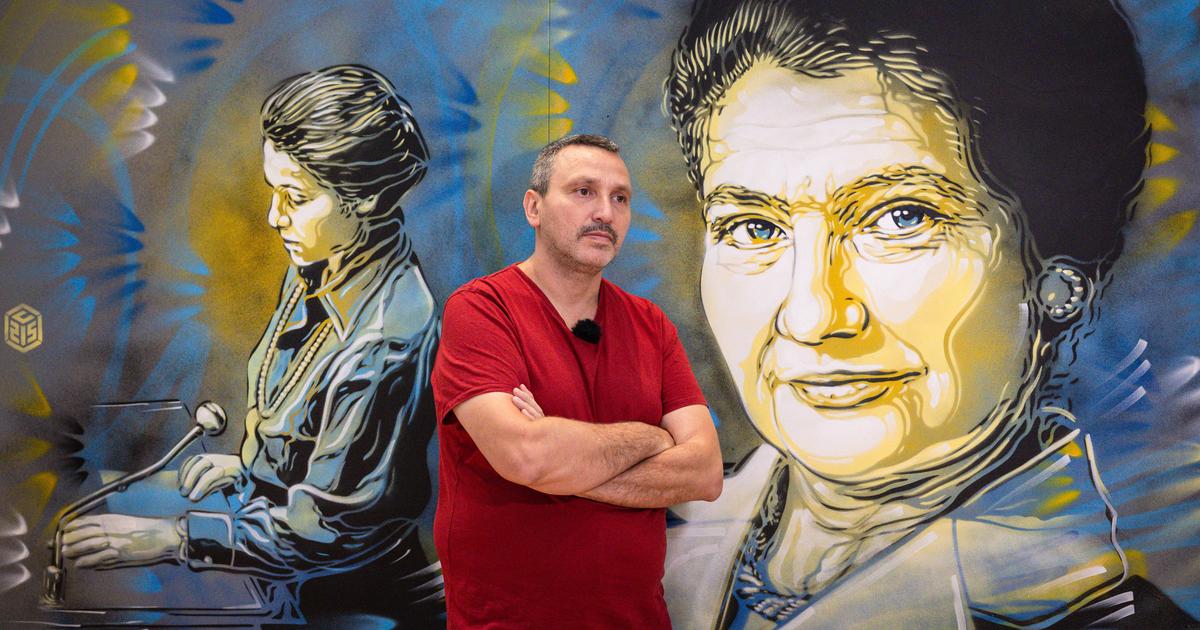The Inguimbertine, France’s only library-museum, is hosting the Parisian artist, known for his committed stencils and murals, until the end of October.
As soon as you enter a sumptuous 18th-century building, a cat drawn in profile watches visitors with its piercing eyes. In Carpentras, an XXL exhibition illustrates the love story between C215, a world-renowned Parisian street artist, and this Provençal town of 30,000 inhabitants.
The Inguimbertine, a unique library-museum in France, welcomes in its “royal gallery” part of this event dedicated to Christian Guémy, alias C215. There follow one another through several paintings, portraits or colorful everyday objects, themes dear to the artist: childhood, figures of the Resistance, poetry and the cat, his favorite animal. C215 is known throughout the world for his committed stencils and murals, for example in homage to the victims after the attack against the satirical newspaper Charlie Hebdo in 2015 in Paris or in support of Ukraine at war with Russia.
Since the opening of the Inguimbertine in April, “My first project was to introduce it to a contemporary artist”its director, Jean-Yves Baudouy, explains to AFP. But there is no question of opening the doors of this unique mixed cultural venue in France and its treasure – nearly 100,000 paper or digital books, 1,200 paintings, 500 statues and 3,400 manuscripts – to just anyone.
“Who among contemporary artists places the public at the heart of his creation? It is the street artist, who creates in public space”smiles Mr. Baudouy. Dedicating the first temporary exhibition (until October 31) of the Inguimbertine – named after its founder Malachie d’Inguimbert, a churchman born in Carpentras, in charge of the Pope’s library in Rome in the 18th century – to the world of Christian Guémy, is the fruit of a “happy meeting”says the director.
“Supernatural”
“The idea when we designed the exhibition was to bring urban art into the museum and bring the museum out into the city”explains C215, who once collaborated with his British counterpart, Banksy. “I was given complete carte blanche to organize, using the walls and spaces that could be made available to me, either reproductions of paintings from the (museum) collection or portraits of painters.”
Like Peter Paul Rubens, “one of the great masters of the Renaissance”depicted on a city wall amidst old graffiti. In total, thirty-six works are scattered throughout the old centre of Carpentras among shops and public services, explains the salt-and-pepper-haired stencil artist.
“Carpentras is supernatural”believes Christian Guémy. “A very open city where social classes, cultures and languages mix. From Provençal to the most classical French or Maghrebi Arabic.” et “Hebrew,” he adds. “From the 14th century, Carpentras was a land of asylum for the Jewish community, long persecuted by the Kingdom of France, then welcomed various immigrant populations.” The artist discovered the city thanks to his partner: “She grew up here, my in-laws live here, my children have spent all their holidays here since they were born.”
Satisfied visitors
At the library as in town, the exhibition appeals to all ages. “It’s a very nice initiative”judge Michel Bernard, 73 years old, retired, delighted to find in drawings characters who marked his youth like the Minister of Health, Simone Veil, famous for having adopted the law decriminalizing abortion in France, or André Malraux, novelist then Minister of Culture.
“I didn’t expect to find here, an almost poetic vision of art in the street!”smiles his sister-in-law Annie Vinter, 67, a university professor in Dijon. Logan Vincent, 43, a home care worker, was able to meet C215 to congratulate him and take a selfie: “For years, I’ve seen his work on post office mailboxes, everywhere. And now, I see it in real life!”
Perceiving the satisfaction of the people of Carpentras responds to Christian Guémy’s desire: “To free myself, including from performance, to work on confidential, less mainstream things.” The one who divides his time between Île-de-France and Carpentras gives himself a year to settle down permanently: “I bought a house (…), I don’t know if I’ll live there for the rest of my life but it’s set to (last) a good while.”
